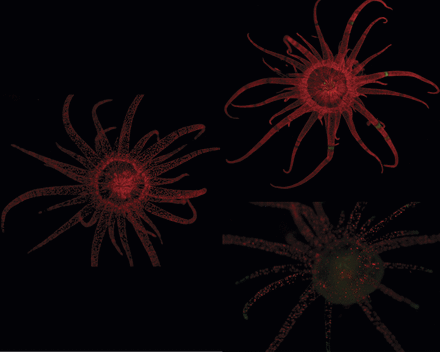Coral reefs around the world are “bleaching”, a threat caused by breakdown of the symbiosis between the coral animals (cnidaria) and the dinoflagellate algae that live within their cells. Yet this crucial symbiotic partnership is poorly understood. To address this knowledge gap, biologists are developing a suite of genomic tools for the sea anemone Aiptasia. This fast-growing cousin of corals maintains a similar symbiotic relationship with dinoflagellates, but it can also survive without its symbiotic friends.
In the February issue of G3: Genes|Genomes|Genetics, Lehnert et al. exploit this ability of Aiptasia to live without dinoflagellate symbionts to study gene expression patterns associated with the symbiotic state. They first had to assemble annotated transcriptomes for both Aiptasia and its dinoflagellate partner using RNA-Seq. They then compared transcript abundances between symbiotic and aposymbiotic (dinoflagellate-free) anemones. The authors identified nearly 1000 differentially expressed genes, in contrast to previous studies using less sensitive methods. These results provide important clues to how the symbionts regulate their relationship and will serve as a crucial genomic resource for future studies.
Lehnert E.M., M. S. Burriesci, N. D. Gallo, J. A. Schwarz & J. R. Pringle (2013). Extensive Differences in Gene Expression Between Symbiotic and Aposymbiotic Cnidarians, G3, 4 (2) 277-295. DOI: 10.1534/g3.113.009084http://www.g3journal.org/content/4/2/277.full













